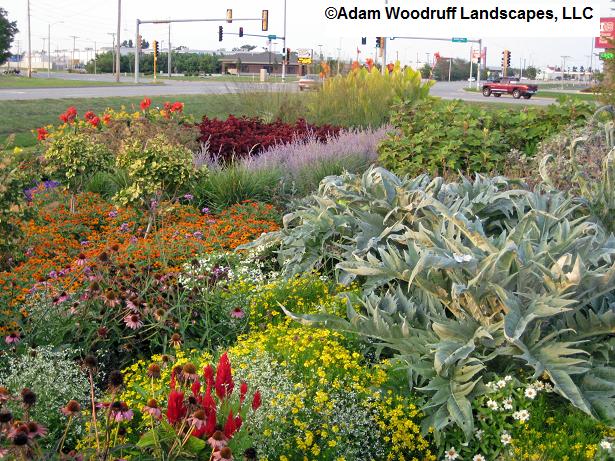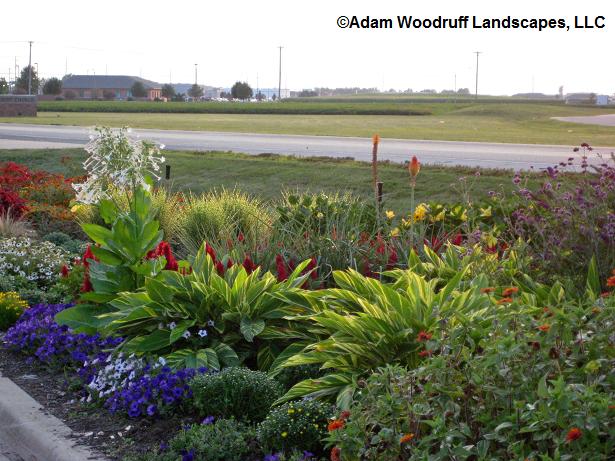For the past several weeks, I have been poring over photos of the Gardens at the Bank of Springfield, scrutinizing this season’s plant combinations and working on my spring planting plan. I’ve come to appreciate the large percentage of annuals and tropicals used on the site. They are essential to the success of this 55-mph (Zone 5) landscape. Annuals ensure consistent bloom and vibrant color. In addition, the use of annuals provides me an opportunity not typically afforded designers of commercial landscapes: I am able to evaluate, revise and improve upon my design each season.
You may recall that in my previous post Growth and Inspiration, I mentioned that with grand-scale designs, I create vignettes of plants which support adjacent vignettes, all working together to support a grander visual statement. I strive seasonally to create naturalistic displays with unexpected twists. The twists in my designs often come in the form of tropical foliage used to anchor the vignettes, as well as plenty of head-turning color.
In this post, I am including a few examples of what I consider to be “successful” combinations built around lush foliage plants. In the photo at the top, the seed heads of Pennisetum glaucum ‘Purple Majesty’ provide strong vertical interest. The cultivar’s burgundy foliage is a perfect foil for hot- and cool-color palettes. It’s shown here with reseeding Rudbeckia hirta ‘Indian Summer’ and Helenium ‘Mardi Gras’ (foreground).
Cardoon (Cynara cardunculus), shown in the above photo, is one of my favorite foliage plants. Its architectural presence is useful in large-scale displays. I enjoy contrasting cardoon’s bold, coarse leaves with dainty flowers such as Helenium amarum ‘Dakota Gold’. ‘Dakota Gold’ reseeded from the previous season and effortlessly worked its way between Euphorbia ‘Diamond Frost’ and Zinnia ‘Profusion White’. The ‘Profusion’ series of zinnia is a staple in my designs. Additionally, I have found Euphorbia ‘Diamond Frost’ to be the perfect filler for use around echinaceas.
Canna cultivars act as colorful exclamation points in the garden. as shown in the photo above. I especially enjoy Canna ‘Striata’ with Cleome ‘Spirit Merlot’. A nearby grouping of Rudbeckia hirta ‘Prairie Sun’, perennial ‘Bristol Fairy’ baby’s breath (Gypsophila paniculata), and a few purple-flowering princess flower (Tibouchina) create a vibrant display.
I find the delicate foliage of bronze fennel (Foeniculum vulgare ‘Smokey Bronze’) works particularly well paired with the paddle-shaped leaves of Canna Tropicanna (‘Phaison’).
Additionally, elephant ear (Colocasia) cultivars, croton (Codiaeum variegatum), and coleus (Solenostemon) cultivars like ‘Big Red Judy’, ‘Glennis’, ‘Religious Radish’, and ‘Rustic Orange’ are colorful accents to canna foliage.
Another vibrant foliage plant I enjoy is variegated shell ginger (Alpinia zerumbet). Shown above, it repeats a gold/green variegated pattern found elsewhere in the beds with Canna ‘Striata’ and Miscanthus sinensis ‘Gold Bar’. I surrounded the ginger with intense color: ‘Easy Wave Blue’ petunia, ‘Fresh Look Red’ celosia, and ‘Zowie Yellow Flame’ zinnia. Perennial Kniphofia uvaria ‘Flamenco’ and volunteers Nicotiana sylvestris and Verbena bonariensis provide height in this vignette.
My foliage wish list for ’09 includes some new additions: Colocasia esculenta ‘Black Beauty’, ‘Elena’, ‘Pink China’, and ‘Violet Stem’; Cordyline ‘Red Star’; Dieffenbachia ‘Tropic Marianne’; Euphorbia cotinifolia ‘Burgundy Wine’; variegated tapioca (Manihot esculenta ‘Variegata’); Musa ‘Siam Ruby’; Phormium cultivars; and purple castor bean (Ricinus communis ‘New Zealand Purple’).
I intend to take a calculated risk and use palms in the garden next summer. I am researching several varieties for hot, windy sites, including foxtail palm (Wodyetia bifurcata), adonidia (Veitchia merrillii), Chinese fan palm (Livistona chinensis) and bismarck palm (Bismarckia nobilis).




